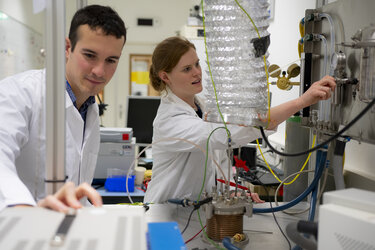Former ESA Research Fellows: Where are they now?
ESA's postdoctoral Research Fellowship Programme offers early-career scientists and engineers the possibility to carry out research in a variety of disciplines related to space science, space applications or space technology. As we launch the 2023 Space Science Research Fellowship Programme, we are inviting former Research Fellows to share their experience at ESA.
This month we are interviewing Christiane Helling, former ESA Research Fellow in the Directorate of Science, and currently Director of the Space Research Institute of the Austrian Academy of Sciences.

Where and in which role are you working today?
I am Director of the Space Research Institute of the Austrian Academy of Sciences and I hold a university professorship for space research at the Graz University of Technology. My working life is threefold: I am director of an international research institute, head of a research group and a university professor who teaches and supervises students. In my director role, I represent the institute externally, nationally and internationally and set the research agenda in collaboration with my fellow group leader colleagues. As a researcher and research group leader, I work with doctoral students and post-docs to decipher the chemical composition of the atmospheres of the more than 5,000 known exoplanets (planets outside of our solar system), aiming to provide insight into the unique nature of each. Complex computer simulations are used as virtual laboratories to explore physical conditions that are inaccessible to laboratories on Earth or for space missions.
What were you doing before joining ESA as Research Fellow?
A fellowship for equal opportunity from Berlin, Germany, funded my research at the University of Leiden where I was looking for opportunities to continue my research career. At that time, nobody in Leiden was working on brown dwarf or exoplanet atmospheres.
What did you work on during your fellowship at ESA?
I worked on modelling cloud formation in brown dwarf atmospheres, in particular on the effect of turbulence on the cloud formation processes. This work is the basis for our cloud formation model that we now apply for exoplanets. During this time, I learned about the Lorentz Center workshops at the University of Leiden and organised a meeting “From Brown Dwarfs to Planets: Chemistry and Cloud Formation”, to which all researchers working on cloud modelling were invited. Everyone came and we published a joint paper in Astronomy & Astrophysics afterwards.
Do you have a most memorable moment from your time as a Research Fellow?
One memorable moment was when we, the Research Fellows, were invited to see the Herschel satellite arriving for radiation testing. Also memorable was the welcoming atmosphere created by the exoplanet/disk people for the Research Fellows. I am immensely grateful also for the environment of curiosity they enabled by making clear that they all were working under a good amount of pressure to see “their” missions succeed.

Where did your path lead to after your RF experience?
I took up an Advanced Fellowship of the Scottish Universities Physics Alliance (SUPA) at the University of St Andrews. In 2010 I won an ERC Starting Grant and shortly after was promoted to Tenure in the form of a lectureship at the University of St Andrews. Four years later, I was promoted to Reader (Associated Professor) and then, seven years after that, to Professor (Chair) in Physics and Astronomy. In 2016, I became the founding director of the St Andrews Centre for Exoplanet Science (StA-CES) where we brought together researchers from different disciplines including physics, astronomy, geosciences, philosophy and languages. This was a pioneering idea. The year of my promotion to Chair of Physics and Astronomy fell right into the Brexit turmoil in the UK which eventually resulted in my leaving the UK.
What was the most valuable takeaway from your experience at ESA?
ESA is a melting pot of different cultural backgrounds, different educational systems and different subjects which all aim to bring the next generation of technology into space. The weight of this challenge is humbling, to say the least.
Is there anything else you would like to tell early career researchers who are planning to apply for Research Fellowships at ESA?
As with every job, it is helpful to make contact with the organisation and the people one wishes to work with.

Call for applications
ESA has selected 12 new Fellows to pursue their own independent research in space science in 2023. The Research Fellowships in Space Science represent one of the highlights of the ESA Science Programme. Early career postdoctoral scientists are offered the unique opportunity to carry out advanced research related to the space science areas covered by ESA Science missions at one of three ESA establishments (ESAC, ESTEC or STScI) for a period of up to three years.
The fellowships cover a broad range of research areas, including the origin of nature’s most powerful explosions, the composition of the exospheres of Jupiter’s moons, Europa and Ganymede, and the processes governing the heating of the solar corona. Learn more about the Fellows and their research here.
Applications for the Space Science Research Fellowships open yearly. The next call for applications will open on 28 August 2023. More information can be found here.
Life at ESA
ESA is proud to offer its employees a stimulating and inspiring work environment that is complemented by myriad on-site services and facilities that make their ESA experience outside of work equally as rewarding.
Learn more about life at ESA.















 Germany
Germany
 Austria
Austria
 Belgium
Belgium
 Denmark
Denmark
 Spain
Spain
 Estonia
Estonia
 Finland
Finland
 France
France
 Greece
Greece
 Hungary
Hungary
 Ireland
Ireland
 Italy
Italy
 Luxembourg
Luxembourg
 Norway
Norway
 The Netherlands
The Netherlands
 Poland
Poland
 Portugal
Portugal
 Czechia
Czechia
 Romania
Romania
 United Kingdom
United Kingdom
 Slovenia
Slovenia
 Sweden
Sweden
 Switzerland
Switzerland






























